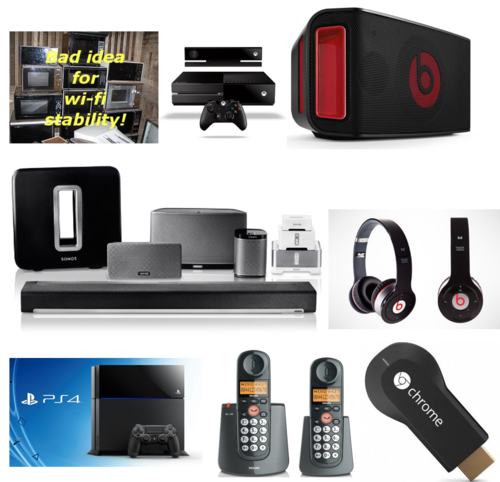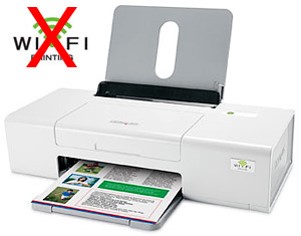Difference between revisions of "Optimize your residence hall Wi-Fi connection"
| Line 17: | Line 17: | ||
===Take a look around for sources of potential interference=== | ===Take a look around for sources of potential interference=== | ||
| − | Such as older microwave ovens, new Internet TVs, cordless phones, Bluetooth devices, wireless speaker systems, Chromecast , or wireless game controllers. These types of devices can (and frequently do – especially in densely packed residence | + | Such as older microwave ovens, new Internet TVs, cordless phones, Bluetooth devices, wireless speaker systems, Chromecast , or wireless game controllers. These types of devices can (and frequently do – especially in densely packed residence halls) interfere with your ability to create or maintain a consistent Wi-Fi connection. |
[[File:wifi_issues-appliances.png|500 px]] | [[File:wifi_issues-appliances.png|500 px]] | ||
Revision as of 18:54, 28 August 2014
How to Optimize Your Dorm Wi-Fi Connection, and What to Do if You Have a Problem
Synopsis:
The wireless signal in my room appears weak or non-existent or my connection is slow- what should I do?
Solution:
First and foremost remember:
Using Wi-Fi is convenient, but unlike other types of data connections, there are more things to consider if it isn’t working well. Unlike a wired connection, Wi-Fi is a shared resource, one in which everyone using it can play a role in making everyone else’s experience better or worse.
All dorm common areas and most rooms at WSU are covered by the Warrior wireless service. If your computer sees the Warrior network but the signal strength is not strong enough to provide a consistent signal, here are troubleshooting steps to follow:
Restart your computer
Once you are disconnected from wired Ethernet or have returned to your room after being at other locations on campus or off, you could restart the machine (a new IP address must be obtained if the computer is to be used on a separate subnet).
Take a look around for sources of potential interference
Such as older microwave ovens, new Internet TVs, cordless phones, Bluetooth devices, wireless speaker systems, Chromecast , or wireless game controllers. These types of devices can (and frequently do – especially in densely packed residence halls) interfere with your ability to create or maintain a consistent Wi-Fi connection.
Older microwaves are particularly bad, as their interference may be temporary and in another room, but the effect on the Wi-Fi access point in the immediate vicinity can be great, including knocking everyone off of the access point while the microwave is cooking. And, even if they don’t kick you off the network, their interference will affect the speed you are connected to the network.
Turn off or disable Wi-Fi on any devices that have it built in, but cannot connect to
Many printers sold today come with a “wireless” option to connect to a Wi-Fi network, and this feature is on by default. Even if you aren’t using Wi-Fi to connect to the printer, the device is likely cogging the airwaves, eating up valuable wireless channel space that is normally used by Warrior.
In order to connect to Warrior, your Wi-Fi device must be capable of 802.1x authentication, and almost no Wi-Fi-enabled printers or similar devices can make that type of connection. Leaving Wi-Fi enabled on these devices causes invisible, but very real, problems for those around you. Often, disabling the Wi-Fi radio on these devices is easy to do, and it can be turned on again when you take it out of the residence hall.
If you go to class and leave your laptop on in your room, you aren’t just wasting electricity; you are needlessly using a wireless channel, even if you aren’t sending and receiving data. Just put your laptop to sleep; you can wake it back up when you are ready to use it again.
Is there a personal wireless access point operating in your room or a nearby room?
Personal access points will interfere with the WSU wireless network, including cell phone hotspots.
Is the wireless signal strength appearing in pockets of space throughout your room?
- (e.g., is there one area which has strong signal strength and another area which has weak signal strength?)
If so, is the pocketed signal strength consistent across various times of day (e.g., if the wireless signal strength on your desk is weaker than other areas in your room, is it weaker in the morning, weaker in the evening, etc)? When you notice the signal strength dropping, is there some activity which always seems to be happening (e.g., your roommate is having six of his/her friends over and they are all using the wireless network, etc.)?
Does your computer receive a stronger wireless signal in other rooms/buildings?
If not, it may be prudent to investigate the operation and viability of your computer's wireless card.
So remember:
- Take a look around for sources of potential interference, such as older microwave ovens, new Internet TVs, cordless phones, Bluetooth devices, or wireless game controllers.
- Turn off or disable Wi-Fi on any devices that have it built in but cannot connect to Warrior.
- Turn off Wi-Fi on devices not actively being used, or put devices to sleep that use Wi-Fi, if you aren’t using them.
- The nature of wireless connections makes them prone to disruption from other devices, such as wireless telephones, microphones, and video systems; microwave ovens; certain types of motors; and other devices that send signals through the air. Unfortunately, sporadic loss of connectivity can happen while using the wireless network. Any activities that require a guaranteed connection should be conducted on the wired network (if the device has a wired port) for best results.
What do I do next?
Please follow these steps before contacting the Helpdesk:
- See if others around you can still connect to Warrior. If they can, and you are the only one having the problem, then you know it is something on your computer. If everyone cannot connect, then someone (not everyone) needs to contact the Technical Support Center. In that case, be sure to note that the entire hall or floor cannot connect, as that will speed troubleshooting.
- Try “repairing” your wireless connection. On Windows, this is as easy as bringing up your Network Connections and selecting the Repair option on your wireless connection. For Macs, you can simply turn Airport off and then on again. This has the effect of causing your wireless connection to really start its connections over, and this can “clear the cobwebs” of a stale connection with bad cached data.
- See if you can connect somewhere other than your room. If you can connect in the common areas and other places but not your room, this will greatly speed up the troubleshooting process. If you still cannot connect in your room after repairing your connection, but you can connect in other buildings or common areas in your residence hall, please let the Technical Support Center know that when you make a request for assistance.
How do I contact Helpdesk?
If you have checked each of these troubleshooting points and the signal strength continues to be weak, Techsupport wants to know about your findings. Please call or email the TSC (x5240 or 507-457-5240 --- techsupport@winona.edu) and let us know the details of your findings. We will dispatch a technician to investigate the problem.


